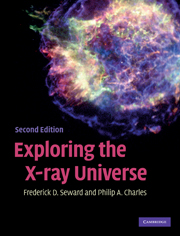Book contents
- Frontmatter
- Contents
- List of acronyms
- Foreword
- Chapter 1 Birth and childhood of X-ray astronomy
- Chapter 2 X-ray emission and interaction with matter
- Chapter 3 Tools and techniques
- Chapter 4 Solar system X-rays
- Chapter 5 X-ray absorption and scattering in the Interstellar Medium
- Chapter 6 Active stellar coronae
- Chapter 7 Early-type stars
- Chapter 8 Supernova explosions and their remnants
- Chapter 9 Neutron stars, pulsars, pulsar wind nebulae, and more supernova remnants
- Chapter 10 Cataclysmic variable stars
- Chapter 11 X-ray binaries
- Chapter 12 Black-hole X-ray binaries
- Chapter 13 Normal and starburst galaxies
- Chapter 14 Active galactic nuclei
- Chapter 15 Clusters of galaxies
- Chapter 16 The diffuse X-ray background
- Chapter 17 Gamma-ray bursts
- Index
- Plate section
Chapter 1 - Birth and childhood of X-ray astronomy
Published online by Cambridge University Press: 05 June 2012
- Frontmatter
- Contents
- List of acronyms
- Foreword
- Chapter 1 Birth and childhood of X-ray astronomy
- Chapter 2 X-ray emission and interaction with matter
- Chapter 3 Tools and techniques
- Chapter 4 Solar system X-rays
- Chapter 5 X-ray absorption and scattering in the Interstellar Medium
- Chapter 6 Active stellar coronae
- Chapter 7 Early-type stars
- Chapter 8 Supernova explosions and their remnants
- Chapter 9 Neutron stars, pulsars, pulsar wind nebulae, and more supernova remnants
- Chapter 10 Cataclysmic variable stars
- Chapter 11 X-ray binaries
- Chapter 12 Black-hole X-ray binaries
- Chapter 13 Normal and starburst galaxies
- Chapter 14 Active galactic nuclei
- Chapter 15 Clusters of galaxies
- Chapter 16 The diffuse X-ray background
- Chapter 17 Gamma-ray bursts
- Index
- Plate section
Summary
The discovery of X-rays
On the second story of the building at Röntenring 8 in Würzburg, Germany, there is a plaque: ‘In diesem Hause entdekte W. C. Röntgen im Jahre 1895 die nach ihm benannten Strahlen’ – In this building, in the year 1895, W. C. Röntgen discovered the radiation named for him. Here was the laboratory of Wilhelm C. Röntgen, a 50-year-old professor of physics, who was studying phenomena associated with electrical discharge in gasses. On the afternoon of 8 November, working alone in his laboratory, he noticed a curious phenomenon. When high voltage was applied to the electrodes in the partially evacuated glass discharge tube, he noticed a faint glow from a fluorescent screen placed at the other end of the laboratory table. The room was dark and he had previously covered the tube with black cardboard so no light would escape. Why was the screen glowing?
That evening he verified that the discharge tube was indeed the source of the energy that caused the screen to glow, and that no visible radiation was escaping from the shrouded tube. He quickly found that the unknown radiation would pass through paper, wood, and aluminum but was stopped by heavy metals. Then, when holding a lead disc in front of the screen to observe its shadow, Röntgen also saw the shadow of bones in his hand! In a week he had measured the basic characteristics of this new form of radiation.
- Type
- Chapter
- Information
- Exploring the X-ray Universe , pp. 1 - 11Publisher: Cambridge University PressPrint publication year: 2010



